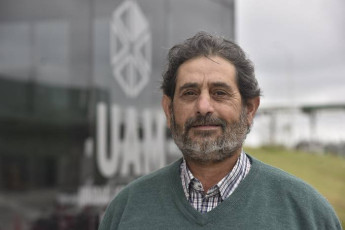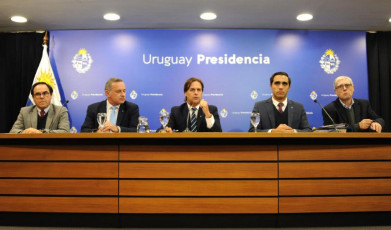Every morning, rural producer Fernando López used to get up, turn on the tap and boil some water to make the traditional Uruguayan mate tea. Over two months ago, he had to change this habit as the only drinking water he can now rely on is bottled water bought at a supermarket near Montevideo, the country’s capital.
But it’s not just mate tea that has been affected. His entire rural property, which produces fruit, is suffering from the historic drought that has hit Uruguay this year. Fernando is President of the National Commission for Rural Development and every day hears stories from colleagues who are losing almost an entire year’s production.
Drought causes billions in losses to farmers

“The Uruguayan drought has many causes and has hit farmers badly. In many cases, farmers will lose 50% to 70% of their entire annual production. It’s not just a loss of volume, it’s also a loss of quality, of caliber for example,” says López.
Dry rivers, yellow pastures, reduced crops and lost millions. This is the picture that the climate crisis is painting in Uruguay. According to the latest official data from the government of Uruguay, the agricultural sector will face losses of over US$2 billion in 2023 and the consequences will persist for the next three years.
Poor water quality
In recent years, the La Niña phenomenon has increasingly turned Uruguay into a desert. It is not only the countryside that has been affected as the capital of Uruguay is also suffering from the worst drought in the last seven decades.
The water quality in Montevideo and nearby cities has worsened because one of the reservoirs that supplies water to the south of the country has dried up due to the lack of rain and because the main freshwater reservoir in Paso Severino, located 80 kilometers north of Montevideo, has practically run dry.
Three consecutive years of drought have emptied the Paso Severino reservoir which this week managed to reach just 7.2% of its capacity thanks to the rains in the last two days, having dropped to 1.7% at the beginning of July.
“The drought that Uruguay is going through is totally exceptional. We had two years of relatively normal drought, with low precipitation rates. But since the end of last year, we have experienced something really exceptional,” says Uruguayan biologist and researcher, Mariana Meerhoff. “We’ve never had such heavy rain.”
To avoid shortages, since the beginning of the year the state water provider, OSE, has gradually been adding brackish water from the Río de la Plata estuary. In May, the mixture reached the maximum levels of sodium and chloride recommended by the World Health Organization (WHO) which gives the water an unpleasant taste and raises concerns about the possible adverse effects on health.
Water emergency

In June, Uruguayan President, Luis Lacalle Pou, declared a water emergency in the Metropolitan Region of Montevideo. This measure provides for tax exemption for bottled mineral water and ensures that the poorest population, those particularly affected by the crisis, receive two liters of water a day free of charge.
Currently, sales of bottled water in supermarkets have tripled. Hospitals and schools in Montevideo are supplied with drinking water from two wells in the center of the city which were drilled as a matter of urgently because of the water crisis.
A new reservoir near the city has been under construction for six months. In addition, repairing old and damaged pipes will soon be on the government’s to-do list as more than half of water supplies are lost during transportation whereas the average for developing countries is 35%, according to the World Bank.
However, according to experts such measures are merely a drop in the ocean and, like many countries and cities around the world, Uruguay urgently needs a water strategy.
“Water crises like this one are going to be more and more frequent and more serious and the government needs to start recognizing the seriousness of the situation,” warns Meerhoff.
Lack of investments
Between the 1990s and 2000, the country went through five drought cycles but according to the Uruguayan Institute of Meteorology, this is the driest period in the country since 1947. In the last three years it has rained 25% less than the historical average and in the first quarter of this year, there was a 43% reduction in precipitation.
In addition to the drought, Uruguay has been slow to invest in basic sanitation and new water infrastructures. The Paso Severino reservoir was opened in October 1987 and is the last major project to be carried out by the South American country. The Casupá reservoir was on the agenda of the last three governments designed and was the Casupá reservoir, expected to be delivered in June 2024, with an investment of US$ 100 million. However, President Lacalle Pou decided to bet on an alternative plan from a group of investors and build a drinking water plant in Arazatí which is located in the west region of Montevideo. The idea was to remove salt water from the Rio de la Plata and transform it into fresh water. Investments were forecast at US$280 million but as yet nothing has come to fruition.

